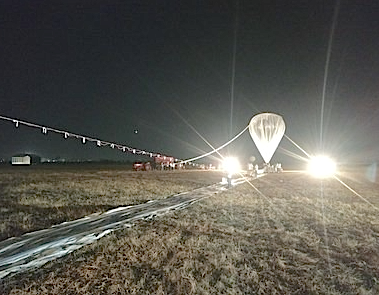India's Big Balloon ... First Sudent-Led Micro Satellite Launch
The balloon facility is located on the ECIL campus and the micro satellite will help in understanding cancer-causing cosmic radiation that constantly bombards the Earth.
The micro satellite was developed by undergraduate students of BITS Pilani, Goa campus, under project Apeiro. The micro satellite is aimed at detecting and measuring cosmic radiation in stratosphere, one of the layers of atmosphere surrounding the Earth.

According to officials, the study is important to understand the biologically harmful cosmic radiation incident on the Earth from outer space. Extended exposure to this radiation leads to an increased risk of cancer and tissue damage. A thorough understanding of this radiation is essential to develop predictive and preventive mechanisms against their impact.
The experiment was conducted using high altitude ballooning technique. This method allows studies in the near-space environment with the help of a zero-pressure plastic balloon which lifts the experimental payload to desired altitude. The experimental payload consisted of a cosmic radiation detector made with a combination of scintillator and photomultiplier tubes.
This detector system was supported by an on-board high and low voltage power supply systems along with data acquisition systems. The TIFR in the city is one of the few institutes in the world capable of supporting such kind of a flight. The balloon and all other flight equipment required for the flight of the Project Apeiro payload were developed entirely at this facility.
The payload was launched at 2:12 am February 2 and achieved a first float altitude at 24.8 km. The second float altitude was achieved at 26.7 km. "This flight sets history by successfully completing the country's first near-space experiment completely developed by students," says an official statement.
The student team comprised Sanket Deshpande, Lucky Kapoor, Shivangi Kamat, Vibhav Joshi and Pankaj Tiple. The project mentor is Dr B Satyanarayana of TIFR, Mumbai. Prof Devendra Ojha, chairperson of TIFR Balloon Facility, Hyderabad, Suneel Kumar, scientist-in-charge, TIFR Balloon Facility, and Srihari Menon of University of Pennsylvania, USA, were also part of the project.
Shaanxi Probecom Microwave Technology Co.,LTD (abbreviated as Probecom), was founded in 2002, located in International Trade and Logistic Park in Xi’an, we are mainly engaged in the design and manufacture of all types of satellite communication Earth Station Antenna, VSAT Antenna, Ka Series Antenna, Portable Flyaway Antenna, RxO/TVRO Antenna, SNG Antenna, On-the-Move Antenna, Remote Sensing & Telemetry Antenna, Meteorological Radars, High Power and Ultra Wideband Amplifiers (SSPA & TWTA), Microwave Components as well as the related Antenna Control & Tracking System.

